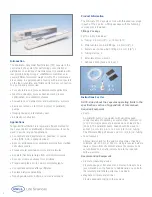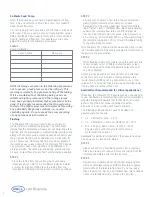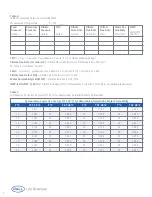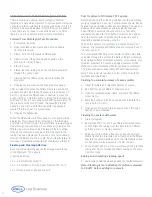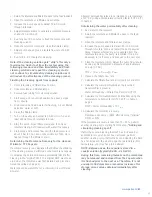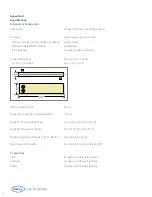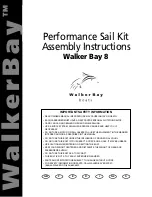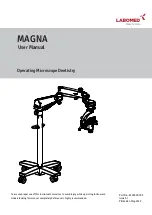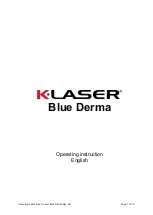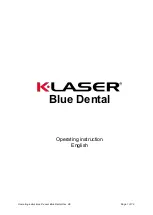
Calibrate Feed Pump
Note: If the pump does not have a digital read out of flow
rate, it may be useful to calibrate the pump. This makes it
easier to set flow rates.
Connect tubing to the pump and put both ends in a reservoir
with water. Prepare a pump curve by measuring flow rate at
different settings. Take measurements at 5 or more settings.
Record setting and flow rate. This will allow you to easily
adjust flow rates for the following procedures.
Table 1
Pump Calibration
Pump Setting
Flow Rate
NOTE: Warnings are given in the following procedures
not to exceed a feed pressure of 2 bar (30 psi). This
warning is related to the pressure rating of the tubing.
If it is ascertained that the tubing being used can
withstand higher pressures and the tubing clamps
have been properly installed, higher pressures can be
used. It is strongly recommended that the system be
tested at the higher pressures with water before using
any potentially dangerous solutions, i.e. caustic
sanitizing agents. Do not exceed the pressure rating
of any component in the system.
Flushing
The Minimate TFF Capsule contains traces of glycerin
(humectant) and preservative (biocide). The humectant
insures that the membrane will easily accept water and allow
high flux, and the preservation combats microbial growth during
storage. These compounds should be flushed out before use.
More rigorous flushing and sanitization may be required for
more critical uses, while less flushing may be acceptable if
the intended use is less critical. If the Minimate TFF Capsule
has previously been used, cleaned and equilibrated in a
storage solution, the same preconditioning procedure may
be used. Follow these steps to flush out the storage solution.
STEP 1
Place the tubing from the suction side of your pump
(feed) into about 1 liter of 0.2 um-filtered deionized water
or water for injection (WFI). Place the tubing from the
retentate and filtrate ports into a drain or waste container.
STEP 2
Adjust pump to deliver a flow rate of about 40 mL/min.
Slowly tighten retentate screw clamp to increase
backpressure. This will increase flow through the filtrate
lines. Tighten clamp until filtrate flow rate is approximately
equal to the retentate flow rate or until feed pressure
reaches 2 bar (30 psi). Do not exceed a feed pressure of
2 bar (30 psi). Pump at least 250 mL of the water through
the retentate tubing and 250 mL through the filtrate tubing
to the drain (>500 mL total).
If the Minimate TFF capsule will not be sanitized prior to use,
it is recommended that this step is repeated to further remove
the glycerin and preservative.
STEP 3
When flushing is almost complete, open the vent port and
collect at least 10 mL of filtrate. A small beaker or test
tube can be used to collect the liquid. Replace the vent
cap when finished.
A three-port valve with luer connectors may be attached
to the drain port. A short piece of tubing attached to a
luer-to-hose-barb fitting can be connected to one of the
valve port. The valve can then be turned to drain the liquid
into the beaker or close off the port.
Sanitization (Recommended for critical applications)
If required, the Minimate TFF Capsule may be sanitized prior
to use. Sanitization is recommended whenever full compliance
with USP Biological Reactivity Test In Vitro <80> is required.
Refer to the MSDS for proper handling and safety
precautions when working with caustic solutions.
The following solutions can be used to sanitize and
depyrogenate the capsule.
1. 0.1 – 0.5N NaOH @ 35 – 45 °C
2. 0.1 – 0.5N NaOH + 200 ppm NaOCl @ 35 – 45 ºC
3. 200 – 400 ppm NaOCl (pH 6 – 8) @ 25 – 45 ºC
(Should not be used if any metal parts come in
contact with the solution.)
Sanitization is particularly important if the capsule has been
previously used, cleaned and stored.
STEP 1
Add about 200 mL of sanitizing solution into a reservoir.
Place feed tubing into reservoir. Place the tubing from the
retentate and filtrate ports into the reservoir.
STEP 2
Adjust pump to deliver about 50 mL/min. Slowly tighten
clamp on retentate tubing until filtrate flow rate is approx
mately 25% of the retentate flow rate. Do not exceed a
feed pressure of 2 bar (30 psi). If filtrate flow rate is already
>25% of retentate flow rate, proceed to next step.
4


